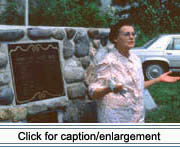|
The procession started at the Frenchville Town Office and wound
its way down U.S. Route 1 to the Community Center where a free community
picnic was held. An estimated 600 individuals were served at the picnic.
Sunday evening saw the church filled with spectators as Les Chanteurs
Acadiens filled the air with traditional French and Acadian songs. Antiques
were on exhibit at the church Monday and an evening of prayer was held
there last night, Tuesday. There's a Veillée pour les vieux tonight
at the community center, an evening for the young tomorrow night there,
Josée Vachon performs at the church on Friday evening, there's an
arts and crafts fair Saturday, and the Sesquicentennial Mass will be
held at 3 p.m., followed by a banquet at the Community Center.
These successful public events garner considerable local publicity, and
in turn, may affect private behavior and values. Reunions, weddings, and
anniversary celebrations are often scheduled to coincide with summer vacations
when relatives "from away" visit the Valley.
The Acadian banner is prominently displayed throughout the Valley, especially
during festivals and celebrations. A yellow star transforms the French tricolor into the Acadian banner.
It originated in the Canadian Maritimes in 1884 and was adopted as a cultural
symbol by Maine Acadians in the 1970s. The banner is flown, along with
the Maine State and United States flags, at many civic events in the Upper
St. John Valley. A representation of the banner introduces each chapter
in the print version of this report.
A yellow star transforms the French tricolor into the Acadian banner.
It originated in the Canadian Maritimes in 1884 and was adopted as a cultural
symbol by Maine Acadians in the 1970s. The banner is flown, along with
the Maine State and United States flags, at many civic events in the Upper
St. John Valley. A representation of the banner introduces each chapter
in the print version of this report.
Public awareness about and interest in Maine Acadian identity has developed
throughout the Valley in response to the changes described above, inspired
in part by the national trend toward celebrating ethnic roots and distinctiveness.
Individuals even embrace Maine Acadian identity when their active connection
to Maine Acadian culture is limited. Verna Cyr, who was born in Fort Kent
but only recently began to think of herself as a Maine Acadian, explained
(focus group 1993):
My grandmother was a Hafford, which was English, and in those days
the mother was with the children [always]. So I just thought I was Acadian,
after I took a night course [on Maine Acadian history].
In the Upper St. John Valley, many Maine Acadians now feel a responsibility
for maintaining their culture, not only for their own communities, but
for the benefit of others. Speaking of the second and third generation
living away from the Valley, Bernette Albert of Madawaska commented before
the Maine Acadian Culture Preservation Commission (June 1993):
Commission (June 1993):
We know who we are, but the young ones don't. . . . And that's why
they come, for instance, to our family reunions. They come from every
province in Canada. They come from every state in the Union. Why? They
don't come to . . . see Fraser Paper. No question about it. They come
to find out who they are.
Maine Acadians consider the Upper St. John Valley their cultural home
whether they live in Van Buren or Virginia Beach, St. Agatha or San Diego.
Geographically dispersed, they construct and maintain their ethnic identity
in a variety of ways according to individual experience and community
norms. This chapter has looked at some of the principle markers of cultural
identity; at their expression and use in contemporary public contexts
at the "hearth" of Maine Acadian culture.
|

